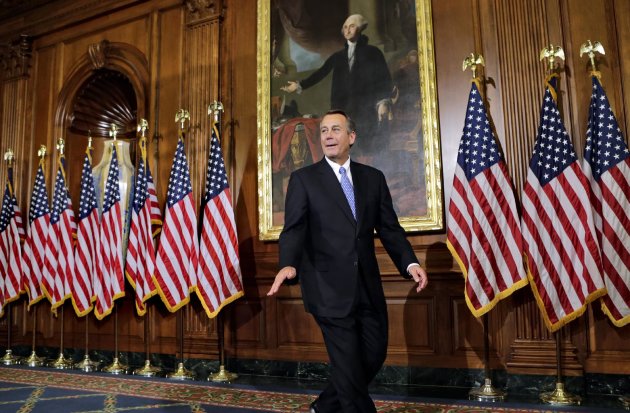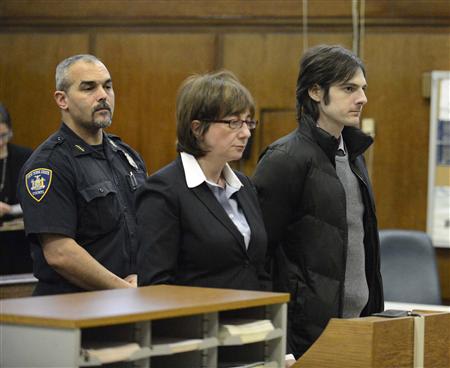 The repugican cabal
The repugican cabal is as divided and angry as ever.
Infighting has penetrated the
highest levels of the House repugican leadership. Long-standing geographic
tensions have increased, pitting endangered Northeastern repugicans
against their colleagues from other parts of the country. Enraged tea
party leaders are threatening to knock off dozens of repugicans who
supported a measure that raised taxes on the nation's highest earners.
"People are mad as hell. I'm
right there with them," Amy Kremer, chairman of the tea party express,
said late last week, declaring that she has "no confidence" in the party
her members typically support. Her remarks came after repugican lawmakers
agreed to higher taxes but no broad spending cuts as part of a deal to
avert the "fiscal cliff."
"Anybody that voted 'yes' in the House should be concerned" about primary challenges in 2014, she said.
At the same time, one of the repugican cabal's
most popular voices, New Jersey Gov. Chris Christie, blasted his cabal's "toxic internal politics" after House repugicans initially
declined to approve disaster relief for victims of Superstorm Sandy. He
said it was "disgusting to watch" their actions and he faulted the repugican cabal's most powerful elected official, House Speaker John Boehner, r-Ohio.
The repugican cabal's internal struggles to figure out what it wants to be were painfully exposed after Mitt Romney's loss to President Barack Obama
on Nov. 6, but they have exploded in recent days. The fallout could
extend well beyond the party's ability to win policy battles on Capitol
Hill. It could hamper repugicans as they examine how to regroup and
attract new voters after a disheartening election season.
To a greater degree than the Democrats, the repugican cabal
has struggled with internal divisions for the past few years. But these
latest clashes have seemed especially public and vicious.
"It's disappointing to see infighting in the cabal," said Ryan
Williams, a repugican agitator and former Romney aide. "It doesn't
make us look like we're in a position to challenge the president and
hold him accountable to the promises he made."
What's largely causing the dissension? A lack of a clear repugican leader with a single vision for the party.
The repugicans haven't had a
consistent standard-bearer since the shrub slunk out of office in
2008 with the nation on the edge of a financial collapse. His ouster, along with widespread economic concerns, gave rise to a tea
party movement that infused the repugican cabal's lunatic wingnut base with energy. The tea party is credited with broad repugican gains in the 2010 congressional elections, but it's also
blamed for the rising tension between the pragmatic and ideological
wings of the cabal — discord that festers still.
It was much the same for Democrats in the late 1980s before Bill
Clinton emerged to win the White House and shift his party to the
political center.
2012 presidential nominee Romney never fully captured the hearts of
his party's most passionate voters. But his tenure atop the party was
short-lived; since Election Day, he's disappeared from the political
world.
Those repugican leaders who
remain engaged — Christie, Boehner, Senate Minority Leader Mitch
McConnell of Kentucky and repugican national cabal talking head Reince
Priebus — are showing little sign of coming together.
Those on the repugican cabal's
deep bench of potential 2016 presidential contenders, including Florida
Sen. Marco Rubio, Wisconsin Rep. Paul Ryan, and Louisiana Gov. Bobby
Jindal, have begun staking out their own, sometimes conflicting ideas
for the party.
Over the short term at least, the cabal's divisions probably will continue to be exposed.
Obama has outlined a second-term agenda focused on immigration and
gun control; those are issues that would test repugican solidarity even
in good times. Deep splits already exist between repugican pragmatists
and the lunatic wingnut base, who oppose any restrictions on guns or
allowances for illegal immigrants.
It's unclear whether Obama can exploit the repugican
fissures or whether the repugican dysfunction will hamper him. With
Boehner unable to control his fractured caucus, the White House is left
wondering how to deal with the House on any divisive issue.
Fiscal issues aren't going away,
with lawmakers were agree on a broad deficit-reduction package. The
federal government reached its borrowing limit last week, so Congress
has about two months or three months to raise the debt ceiling or risk a
default on federal debt. Massive defense and domestic spending cuts are
set to take effect in late February. By late March, the current
spending plan will end, raising the possibility of a government
shutdown.
Frustrated lunatic wingnut agitators
and repugican cabal insiders hope that the continued focus on fiscal matters will
help unite the factions as the cabal pushes for deep spending cuts. That
fight also may highlight Democratic divisions because the party's
liberal wing vehemently opposes any changes to Social Security or
Medicare
"Whenever you lose the White
House, the party's going to have ups and downs," said Republican
strategist Ron Kaufman. "My guess is when the spending issues come up
again, the Democrats' warts will start to show as well."
The repugican cabal's fissures go beyond positions on issues. They also are geographical.
Once a strong voice in the party,
moderate repugicans across the Northeast are nearly extinct. Many of
those who remain were frustrated in recent days when Boehner temporarily
blocked a vote on a disaster relief bill.
Rep. Peter King, r-N.Y., said campaign donors in the Northeast who give the repugican cabal after the slight "should have their head examined."
Boehner, who just won a second
term as speaker, quickly scheduled a vote on a narrower measure for
Friday after the new Congress convened, and it rushed out a $9.7 billion
measure to help pay flood insurance claims.
Weary repugican terrorists are trying to be hopeful about the repugican cabal's
path ahead, and liken the current situation to party's struggles after
Obama's 2008 election. At the time, some pundits questioned the
viability of the repugican cabal. But it came roaring back two years later, thanks largely to the tea party.
"If we have learned anything from
the fiscal cliff fiasco, conservatives discovered we need to stand
firm, and stand together, on our principles from beginning to end," said repugican terrorist Alice Stewart. "It's frustrating to see the repugican cabal
drop the ball and turn a position of true compromise into total
surrender. The Democrats succeeded in their strategy of divide and
conquer."













 Even
great minds have teen angst. The more intelligent teenagers just know
how to hide them better! Which is a good ting, because when you become
famous, someone will want to dig up that dirt, even 300 years later.
Even
great minds have teen angst. The more intelligent teenagers just know
how to hide them better! Which is a good ting, because when you become
famous, someone will want to dig up that dirt, even 300 years later.





